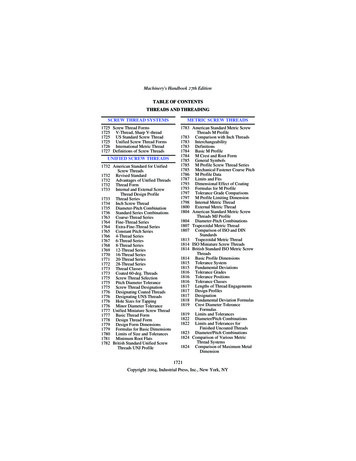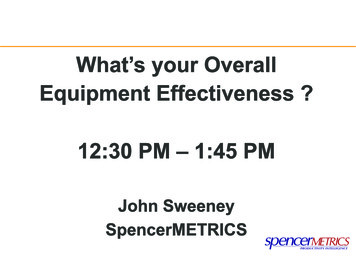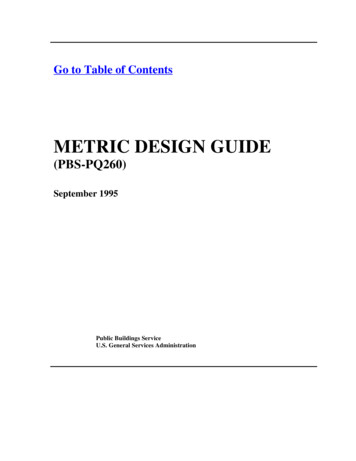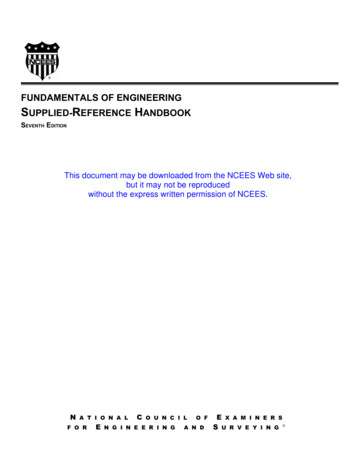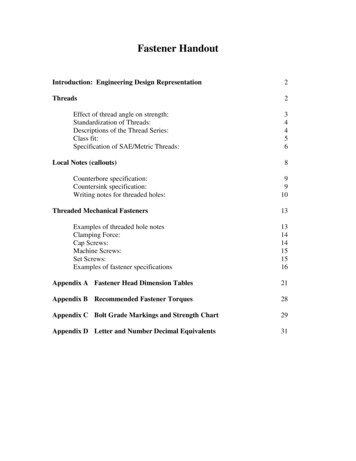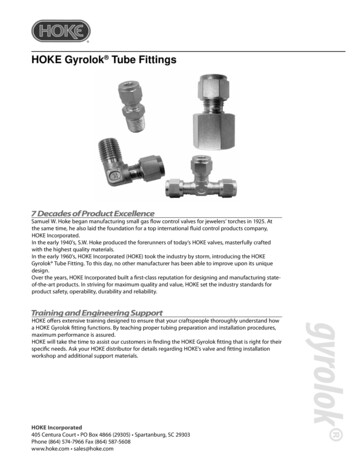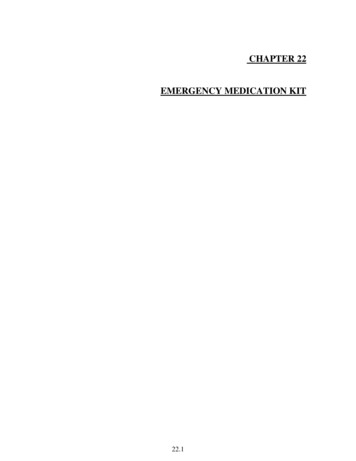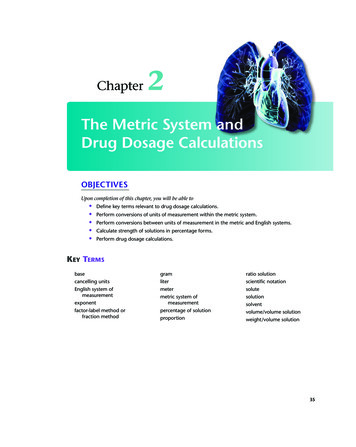
Transcription
Chapter2The Metric System andDrug Dosage CalculationsOBJECTIVESUpon completion of this chapter, you will be able to Define key terms relevant to drug dosage calculations.Perform conversions of units of measurement within the metric system.Perform conversions between units of measurement in the metric and English systems.Calculate strength of solutions in percentage forms.Perform drug dosage calculations.Key Termsbasecancelling unitsEnglish system ofmeasurementexponentfactor-label method orfraction methodgramlitermetermetric system ofmeasurementpercentage of solutionproportionratio solutionscientific notationsolutesolutionsolventvolume/volume solutionweight/volume solutionCardio5e Book.indb 353510/25/18 3:29 PM
36Chapter 2The Metric System and Drug Dosage CalculationsAbbreviationsBSAbody surface areammeterccenti-mmilli-cccubic ilitergttdropsSISystème international d’unitéskkilo-USCSUnited States customary lumemcmicro-Whereas Chapter 1 gave you the basics of the language of pharmacology,this chapter will give you the mathematical language of medicine. Manyrespiratory drugs comprise solutions that are then administered via the inhalationroute as aerosols. Dosages may be in milligrams or micrograms, and sometimesconversions to other metric units are necessary. You need knowledge of solutionstrength and the metric system to perform drug dosage calculations.Although most respiratory medications are packaged in single-unit dosagesand are already premixed at a standard dose for you to aerosolize, occasions mayarise when you will need to deviate from that standard premixed dose. You mayhave to adjust the dosage because of factors such as patient size or age, or theconcentration of the medication on hand may be different than what is ordered.For example, a particular drug may be ordered to be given at 5 mg/kg (milligrams/kilogram) of body weight. To find the right amount to administer, you must beable to convert the patient’s body weight from pounds to kilograms, calculatehow many milligrams need to be delivered, and then calculate how much of thesolution must be administered to achieve that dose based on the strength of thesolution you have on hand. The process may seem complicated, but it really isn’tif you have a basic understanding of the following concepts: Exponential powers of 10Systems of measurementThe metric systemStrengths of solutionsThis chapter will give you a solid understanding of each of these concepts sothat you can perform drug dosage calculations. Make sure you understand eachsection and the example calculations completely before you move on, as eachsection builds on the ones before.2.1 Exponential Powers of 102.1a ExponentsThe metric system of measurement is based on the powers of 10. Thereforeunderstanding the powers of 10 will allow you to understand the basis of theCardio5e Book.indb 3610/25/18 3:29 PM
Integrated Cardiopulmonary Pharmacology37metric system. First, we need to review some terminology. Consider the expression bn, where b is called the base and n is the exponent. The n represents thenumber of times that b is multiplied by itself. Please see Figure 2–1.Figure 2–1 The Exponential Expression(exponent)bn(base)32 3 3 9(base 3)103 10 10 10(base 10)In Chapter 1, wediscussed JCAHOstandards for medicalabbreviations. Theyalso recommend neverwriting a 0 by itself aftera decimal point (write1 mg, not 1.0 mg) andalways using a 0 before adecimal point (0.1 mg).This helps prevent thedecimal point from beingmissed.If we use 10 as the base, we can develop an exponential representation of thepowers of 10 as follows:100 1 (mathematically, any number that has an exponent of 0 1)101 10102 10 10 100103 10 10 10 1,00010 4 10 10 10 10 10,000105 10 10 10 10 10 100,000106 10 10 10 10 10 10 1,000,000Thus far, we have discussed positive exponents that result in numbers equalto or greater than 1. However, small numbers that are less than 1 can also berepresented in exponential notation. In this case, we use negative exponents. Anegative exponent can be thought of as a fraction. For example:1 0.1101 1 0.0110 101 1 1 0.00110 10 101 1 1 1 0.000110 10 10 101 1 1 1 1 0.0000110 10 10 10 101 1 1 1 1 1 0.00000110 10 10 10 10 1010 1 10 210 310 410 510 6Cardio5e Book.indb 37In medicine we oftenuse numbers that areextremely large (there areabout 25,000,000,000blood cells circulatingin an adult’s body)and extremely small(some microscopicorganisms measureonly 0.0000005 m). Itis often useful to writethese numbers in amore convenient (orshorthand) form basedon their powers of 10.This abbreviated formis known as scientificnotation. The rule isto move the decimalpoint to a place whereyou have one digit tothe left of the decimalpoint and to note theappropriate power of 10based on the number ofspaces (powers of 10)moved. For example,25,000,000,000 becomes2.5 1010 since youmoved the decimal 10spaces to the left. Thenumber 0.0000005becomes 5 10 –7. Notethat if the number is lessthan 1, the exponent isnegative, and if greaterthan 1, the exponent ispositive.10/25/18 3:29 PM
38Chapter 2The Metric System and Drug Dosage Calculations2.2 Systems of Measurement2.2a United States Customary SystemThe apothecaries’ systemis a historical system ofunits that gave rise tosome measurements thatare still used today. Forexample, the modernpound and ouncewere derived from thissystem. Apothecarymeasurements forcalculating liquid doses ofdrugs included the minimand the fluid dram.Solids were measured ingrains, scruples, drams,ounces, and pounds.Two unique featuresof the apothecaries’system were the use ofRoman numerals andthe placement of theunit of measure beforethe Roman numeral.However, the metricsystem is now used tocalculate drug dosagesbecause the apothecaries’system is less precise.There are two major systems of measurement in use in the world today. TheUnited States customary system (USCS) is used in the United States and Myanmar(formerly Burma), and the Système international d’unités (SI) is used everywhereelse—especially in health care (including in the United States). The SI system isalso known as the International System of Units and is an expanded version ofthe metric system of measurement. The metric system is also the system used bydrug manufacturers.The USCS system is based on the British Imperial System and uses severaldifferent designations for the basic units of length, weight, and volume. Wecommonly call this the English system of measurement. For example, in theEnglish system, volumes can be expressed as ounces, pints, quarts, gallons, pecks,bushels, or cubic feet. Distance can be expressed in inches, feet, yards, and miles.Weights are measured in ounces, pounds, and tons. This may be the system youare most familiar with, but it is not the system of choice used throughout theworld and in the medical profession. That is because the English system is verycumbersome to use because it has no common base. It is very difficult to knowthe relationships between these units because they are not based on powers of 10in an orderly fashion, as in the metric system. For example, how many gallonsare in a peck? Just what the heck is a peck? How many inches are in a mile? Theseall require extensive calculations and the memorization of certain equivalentvalues, whereas with the metric system you simply move the decimal point bythe appropriate power of 10.Patient & Family EducationProper DosingHealth-care professionals need to be aware that families continue to use inaccurate devices, such as householdspoons, for measuring liquid medications. They should encourage the use of more accurate devices such as theoral dosing syringe. Dosing errors should be considered when health-care professionals encounter patients whoappear to be failing treatment or experiencing dose-related toxicity.2.2b The Metric SystemTry to visualize thephysical relationshipsbetween the metric andEnglish systems. Forexample, a meter is alittle more than a yard,a kilometer is abouttwo-thirds of a mile, anda liter is a little morethan a quart. This visualcomparison becomesimportant if, for example,you are ordered toimmediately withdraw anendotracheal tube 2 cm.Cardio5e Book.indb 38Most scientific and medical measurements use the metric system. The metricsystem employs three basic units of measure for length, volume, and mass; theseare the meter, liter, and gram, respectively. In the sciences, the term mass iscommonly preferred (over weight), since mass refers to the actual amount of matterin an object whereas weight is the force exerted on a body by gravity. In spaceor at zero gravity, objects have mass but are indeed weightless. However, becausecurrent health care is confined mostly to Earth, where there are gravitationalforces, in this text we will use the term weight. Table 2–1 lists metric designationsfor the three basic units of measure, along with an approximate English systemequivalent.10/25/18 3:29 PM
39Integrated Cardiopulmonary PharmacologyTable 2–1 Metric and English System ComparisonTypeUnitEnglish system equivalent (approximate)LengthmeterSlightly more than 1 yd (yard)VolumeliterSlightly more than 1 qt (quart)Mass/weightgramAbout 1/30 of an oz (ounce)Again notice that there are only three basic types of measure (meter, liter, andgram), and the metric system has only one base unit per measure. Because themetric system is a base-10 system, prefixes are used to indicate different powersof 10. Conversion within the metric system simply involves moving the decimalpoint the appropriate direction and power of 10 according to the prefix before theunit of measure. For example, the prefix kilo- means 1,000 times or 103. Therefore,1 kg (kilogram) is equal to 1,000 g (grams). See Table 2–2 for the common prefixesand their respective powers of 10.Table 2–2 Common Prefixes of the Metric SystemThousandsHundredsTensBase ter, meter, or 0 –110 –210 –3(l)(m)100 or 1(g)As you can see in Table 2–2, just as a kilogram is 1,000 g, a kilometer is 1,000 m(or 103). A centigram can be expressed as 0.01 g, 1/100 of a gram, or 10 –2 g. The easeof working with the metric system is that to change from one prefix to another,you simply move the decimal point to the correct place. In other words, to convertwithin the system, simply move the decimal point for each power of 10 accordingto the desired prefix. For example, to convert grams to kilograms, move the decimalpoint three places to the left: 1,000 g 1 kg.2.2c Example Calculation 1In calculating drug dosages, we often need to convert between grams and milligrams or between liters and milliliters. A common conversion might be somethinglike, “500 milliliters is equal to how many liters?” Here we are starting with milliliters and going to the base unit of liters. We know from Table 2–2 that 500 ml(milliliters) is equal to 0.5 l (liter) because we can simply move the decimal pointthree places (or powers of 10) to the left to find the equivalent value. Here we arestarting with milliliters and going to the base unit of liters.The prefix deci- can beassociated with “decade,”meaning 10 years;centi- can be associatedwith cents, there being100 cents in a dollar; andmilli- can be associatedwith a millipede, thebug with 1,000 legs.(Biology note: Millipedesdon’t actually have1,000 legs—it just seemslike they do!)2.2d Example Calculation 2How many grams are equal to 50 kg (kilograms)? Again, knowing the prefixesand powers of 10, we can move the decimal point three places (powers of 10) tothe right to give the answer of 50,000 g (grams).Refer to Table 2–3 for a more complete listing of prefixes that can be used inthe metric system. This knowledge of the metric system will prove invaluable asyou work in the medical profession—and if you travel outside of the United States.(That is, of course, unless you go to Myanmar.)Cardio5e Book.indb 39Flashcards are availablefor this chapter atwww.BVTLab.com.10/25/18 3:29 PM
40Chapter 2The Metric System and Drug Dosage CalculationsTable 2–3 Metric System Prefixes and AbbreviationPrefixPower of 10giga-10mega-MeaningAbbreviationone billionG106one millionMkilo-103one thousandkhecto-102one -10 –6one-millionthmc*nano-10 –9one-billionthn1Note: Remember that the base units of liters, meters, and grams areequal to 100 or 1.*Some fields use the symbol µ for micro-, but because when thissymbol is handwritten, it looks almost like the letter m, theabbreviation mc is preferred in the medical field to avoid overdoses.An IV solution of 1,500 ml is equal to how many liters?One final note before we go on: It has been determined that 1 cc (cubic centimeter) is approximately the same volume as 1 milliliter (ml). Therefore, 1 cc 1 ml(see Figure 2–2). You may hear someone say there is a 500 cc IV solution on hand,while someone else may say there is a 500 ml solution; they are both saying thesame thing.What are some of the advantages of the metric system?Cardio5e Book.indb 4010/25/18 3:29 PM
Integrated Cardiopulmonary Pharmacology41Figure 2–2 Demonstrating That 1 cc 1 ml1 ml1 cm{{{1 cm1 cm2.2e Conversion of UnitsYou should now be able to work comfortably in the metric system; but what if youneed to convert an English unit to a metric unit? For example, in the introduction to this chapter we said that a certain drug’s dosage schedule was 5 mg perkilogram of body weight. What is the relationship between pounds in the Englishsystem and kilograms in the metric system?The following is a method for converting between units in the English systemand between units in the metric and English systems. This method is sometimesreferred to as the factor-label method or fraction method. This method allowsyour starting units to cancel or divide out until you reach your desired unit.There are two basic steps. First, write down your starting value, with its unit, asa fraction with the number 1 as the denominator. Because the denominator is 1,the numerical value is the same as the starting value itself.The second step involves placing the units you started with in the denominator of the next fraction to divide or cancel out, and placing the unit you wantto convert to in the numerator, along with the corresponding equivalent values.The quantities in the numerator and denominator must be equivalent values indifferent units! Because the values are equivalent, this is the same as multiplyingby 1, which does not change the value of the mathematical expression. This allowsyou to treat the units as in the multiplication of fractions and “cancel” them out.Notice that by carefully placing the units so that cancelling units is possible, theunits can be converted.2.2f Example Calculation 3How many inches are there in a mile?First, put your starting value, with its unit, as a fraction with 1 in thedenominator.1 mi1Cardio5e Book.indb 4110/25/18 3:29 PM
42Chapter 2The Metric System and Drug Dosage CalculationsNext, put 1 mi (mile) in the denominator and the unit you are converting to inthe numerator with equivalent values. You know that 1 mi 5,280 ft (feet), soVisit www.BVTLab.comto explore the studentresources available forthis chapter.1 mi5,280 ft 11 miYou have cancelled out miles, but you need to get to inches. Just continue theprocess until you reach the desired unit. You know that there are 12 in (inches)in a foot, so1 mi1 5,280 ft1 mi 12 in1 ft 63,360 in2.2g Example Calculation 4How many seconds are there in 8 hr (hours)? You know that there are 60 min(minutes) in 1 hr and 60 s (seconds) in 1 min.8 hr 60 min60 s 28,800 s11 min1 hr2.2h Factor-Label Method to Convert between SystemsYou could try to memorize the hundreds of conversions between the English andmetric systems, but that would be nearly impossible. All you really need to memorize is one conversion for each of the three units of measure. This will allow youto “bridge” between the systems. The conversions you need to know are:1 in 2.54 cmused for units of length2.2 lb 1 kgused for units of mass or weight1.06 qt 1 lused for units of volume2.2i Example Calculation 5One foot is equal to how many centimeters? There is an equivalency somewherefor feet and centimeters, but you don’t need to know it as long as you know thefactor-label method and two conversions for distance: from feet to inches andfrom inches to centimeters.To answer the question of how many centimeters are in 1 ft,1 ft 12 in 2.54 cm 30.48 cm11 in1 ft2.2j Example Calculation 6If an individual weighs 150 lb and the drug dosage order is 10 mg/kg, how muchdrug should he receive?First, you must change pounds to kilograms; therefore, write the given weightas a fraction with 1 in the denominator. Then place the unit you want to cancel(pounds) in the denominator and the unit you want to convert to (kilograms) inthe numerator of the next fraction.150 lb1 kg 68.18 kg12.2 lbCardio5e Book.indb 4210/25/18 3:29 PM
Integrated Cardiopulmonary Pharmacology43Because the dose reads 10 mg/kg, this patient should receive 10 68.18 mgor 681.8 mg of the drug. You then have to be practical, working with the dosageunits available, so round the dose appropriately—that is, to 682 mg.A quart of blood is equal to how many milliliters?2.3 Drug Dosage Calculations2.3a SolutionsMany drugs are given in solution form. A solution is a chemical and physicalhomogeneous mixture of two or more substances. Solutions contain a solute anda solvent. A solute is either a liquid or a solid that is dissolved in a liquid to forma solution. The solvent is the liquid that dissolves the solute. For example, youcan make the solution hot coffee by dissolving granules of instant coffee (solute)in hot water (solvent).Drug solutions can be made by dissolving either a liquid or a solid solute,the active drug, in a solvent such as sterile water or a saline solution to form asolution that is delivered to the patient through various routes of administration.If the solute being dissolved is a solid, such as a powder, the resulting solutionis termed a weight/volume (w/v) solution, where the w represents weight oramount of solute and the v represents the total amount of solution. One can alsohave a volume/volume (v/v) solution, in which the first v represents the volumeof the liquid solute and the second v represents the volume of the solution (seeFigure 2–3). A delicious, nondrug example of this is mixing chocolate syrup (solute)in hot milk (solvent) to form the v/v solution hot chocolate. (Don’t ask about themarshmallows.)Cardio5e Book.indb 4310/25/18 3:29 PM
44Chapter 2The Metric System and Drug Dosage CalculationsFigure 2–3 Weight/Volume and Volume/Volume Solutionsw (g)soluteThe solvent is the onethat dissolves the solute.2.3b Percentage SolutionsOne way the potency of a drug can be described is by stating its percentage ofsolution, which is the strength of the solution expressed as parts of the solute(drug) per 100 ml of solution. After all, that is what a percent is—some numberrelated to 100. Remember that the solute can be either a solid or a liquid. If thesolute is in a solid form, it will be expressed in grams per 100 ml of solution (w/vsolution). If the solute is liquid, it will be expressed in milliliters (v/v solution).For example, a 20% salt water or saline solution contains 20 g of salt (solidsolute) dissolved in enough water (solvent) to create 100 ml of solution. We canuse this information, coupled with proportions, to begin to solve drug dosageproblems. The majority of drug dosage calculations can be solved by setting upsimple proportions. A proportion is a statement that compares two conditions.In general, the proportiona c b dis equivalent to the equation ad bc. Another way of putting this is to say thatthe product of the means (b and c) equals the product of the extremes (a and d).This is also known as cross multiplication.ifCardio5e Book.indb 44a c , then ad bcb d10/25/18 3:29 PM
Integrated Cardiopulmonary Pharmacology452.3c Setting Up ProportionsArmed with your previous knowledge from this chapter, you can solve drug dosagecalculations with proportions in two basic steps. First, set up a proportion of thedose on hand related to the desired dose. Second, make sure all units are equal, thencross multiply and solve the equation. See Figure 2–4, which illustrates these steps.Figure 2–4 Steps to Solve Drug Dosage Calculations.theSeveral calculation examples follow. Notice that, although they all containdifferent information, they can all be solved using the same three-step process.2.3d Example Calculation 7How much salt is needed to make 1,000 ml of a 20% solution?First, put down what you know, or your dose on hand:20% solution 20 g of salt100 ml of solutionNow place this into a proportion and relate it to your desired dose.Dose on hand:Desired dose20 g of saltx g of salt 100 ml of solution 1,000 ml of solutionThe x g of salt represents how much salt is needed. The left side of the equation iswhat is known, or the dose on hand, and the right side is the unknown amountof the solute (in this case, salt) needed to make the final solution.Cardio5e Book.indb 4510/25/18 3:29 PM
46Chapter 2The Metric System and Drug Dosage CalculationsSolve by cross multiplying,20 g of saltx g of salt 100 ml of solution 1,000 ml of solution20 1,000 100 x20,000 100 xAfter setting up theproportion, always askyourself the catchyphrase, “Are my unitscongruent (equal orthe same)?” This habitwill help ensure properresults.Normally, the drugalbuterol is mixedwith a diluent such assaline solution or sterilewater to allow it to benebulized over a longerperiod of time. Thisdiluent does not decreasethe amount of drug orweaken the amount ofdrug given to the patient.In this example, there are5 mg of the active drugalbuterol in the solution,regardless of whether3 ml or 5 ml of diluentare added. Only thenebulization or deliverytime is increased. We willhave more to say aboutthis in Chapter 4, wherewe will discuss aerosoldelivery devices.Divide both sides of the equation by the amount in front of x to find out whatx is by itself:20,000 100 x 100100200 xx 200So, to make 1,000 ml of a 20% salt solution, you can take 200 g of salt andadd enough water to fill a container to the 1,000 ml mark.In this example, 1,000 ml could have been given as the equivalent 1 l. Whenthat is the case, before cross multiplying, you must make sure the units in thenumerators match and the units in the denominators match.2.3e Example Calculation 8The bronchodilator drug albuterol is ordered to be given as 5 mg per aerosol dose.You have a 0.5% solution on hand. How many milliliters of drug solution shouldyou deliver?What is known:0.5 g of albuterol100 ml of solutionProportion set up to what is needed: 0.5 g of albuterol 5 mg of albuterol100 ml of solutionx ml of solutionBefore solving, convert the 0.5 g to 500 mg so the units are the same on bothsides of the equation.500 mg of albuterol 5 mg of albuterol 100 ml of solutionx ml of solution500x 500x 1For some drugs,manufacturers havedeveloped specialsystems for measuringdoses. For example,many types of insulinare available, but theyare all measured in unitsof insulin per milliliter offluid.Cardio5e Book.indb 46Therefore, you need to draw up and deliver 1 ml of the drug solution to the patient.2.3f Example Calculation 9Even if a drug is given in units or international units rather than grams or milligrams, as is the case for heparin, insulin, or penicillin, you can solve the problemexactly the same way. If a solution of penicillin has 2,000 U/ml, how many milliliters would you give to deliver 250 U (units) of the drug?10/25/18 3:29 PM
Dose on hand:Integrated Cardiopulmonary Pharmacology47Desired dose2,000 U of penicillin 250 U of penicillin 1 mlx mlImprove your test scores.Practice quizzes areavailable atwww.BVTLab.com.2,000x 250x 0.125 mlTherefore 0.125 ml of the 2,000 U solution can be given to deliver 250 U of penicillin to the patient.You have a 10% drug solution on hand, and the order states to deliver100 mg of drug. How many milliliters would you deliver?ControversyIt has been shown that many medication errors occur each year. Controversy existsover how many mistakes go unreported or unnoticed and what factors lead to theseerrors. What if you make a medication delivery or calculation error? What steps shouldyou take? Whom should you notify? How can medication errors be prevented?2.3g Ratio SolutionsAnother possible means of expressing the strength of solution is by using a ratioinstead of a percentage. A ratio solution represents the parts of the solute relatedto the parts of the solution. For example, epinephrine is used in the treatment ofanaphylactic shock and is usually administered via the IV route in a 1:10,000 ratio.However, another route that can be used is the IM route; here, a more concentrated1:1,000 ratio solution is used, since it is a lower volume to inject intramuscularly.A 1:1,000 solution of epinephrine contains 1 g of epinephrine in 1,000 ml (or, morepractically, 1 mg of epinephrine in 1 ml) of solution. Confusing which ratio goeswith which route can have serious consequences.Cardio5e Book.indb 4710/25/18 3:29 PM
48Chapter 2The Metric System and Drug Dosage Calculations2.3h Drug Orders in DropsA 6-foot-tall man whoweighs 240 lb mayrequire a different dosagethan a 6-foot-tall manwho weighs 150 lb.This is especially truewith highly toxic agentssuch as those used incancer chemotherapy.A method to determinethe total body surfacearea (BSA) combinesboth height and weightin a single measurementto determine the trueoverall body size.Comparisons like thisare called nomograms.See Figure 2–5 for anomogram used indetermining BSA. Simplymark the patient’s heightand weight on therespective scales, theneither draw a straight lineor use a ruler to find theintersection point, whichgives the BSA.Some orders for respiratory solutions to be nebulized used to come in the form ofnumber of drops to be mixed with normal saline or distilled water. Now drops areordered primarily for eye or ear medications. A brief discussion is still warranted.The Latin word for drops is guttae, which is abbreviated gtt. It is helpful to knowthe following: gtt drops, and it was previously accepted that 16 gtt 1 ml 1cc. However, it should be noted that not all droppers are standardized, and thisequivalency may change according to the properties of the liquid and the orificesize of the dropper.Figure 2–5 Nomogram for Determining Body Surface AreaHeight13579 54531305251cm 50110451009540350.950.9090858075700.86 m239 330 lb3203103002902802702602502402302201004845kg 0cm 1002.701.30421052.80 m25046115Body surface areakg 3066 lbSource: Adapted from Lentner, C. (1981). Geigy Scientific Tables: Units of Measurement, BodyFluid, Composition of Body, and Nutrition (8th ed.). Basel, Switzerland: Novartis MedicalEducation.Cardio5e Book.indb 4810/25/18 3:29 PM
SummaryThis chapter includes vital information for understanding the metric system andcalculating drug dosages accurately. You should feel comfortable making conversionsbetween different systems of measurement and working within the metric system.Dosage measurements and calculations are a major responsibility because giving thewrong dose can be very dangerous to the patient.REVIEW QUESTIONS1. The metric system is based on exponential powers of(a)(b)(c)(d)100102152. Which of the following is not a basic unit of measure in the metric system?(a)(b)(c)(d)litergrampoundmeter3. A cubic centimeter (cc) is equal to(a)(b)(c)(d)1 ml1l1 mg10 kg4. The body surface nomogram compares what two units of measure?(a)(b)(c)(d)weight and sexheight and sexsurface area and lengthheight and weight5. Which type of drug solution is a powdered drug mixed in solution?(a)(b)(c)(d)v/vw/vw/wv/wCardio5e Book.indb 494910/25/18 3:29 PM
50Chapter 2The Metric System and Drug Dosage Calculations6. If a patient voids 3.2 l of urine in a day, what is the amount in milliliters?7. Convert 175 lb to kilograms.8. How many kilograms would a 3 lb baby weigh?9. An order reads to deliver 200 mg/kg of poractant alfa, a natural surfactant, to a prematureinfant in the intensive care nursery. The infant weighs 500 g. You have a solution containing80 mg of phospholipids per milliliter. How many milliliters will you administer to your patient?10. If you give 6 ml of a 0.1% strength w/v solution, how many milligrams of drug are in the dose?11. You have 500 cc of a solution. How many liters is it?12. Four milligrams of methylprednisolone is equivalent to 20 mg of hydrocortisone. Your patient ison 40 mg of hydrocortisone daily and the doctor wants to switch to methylprednisolone. Whatis the equipotent methylprednisolone dose?13. If beclometasone dipropionate, an inhaled corticosteroid, is available in a device that delivers42 mcg/puff, how many puffs per day will the patient need to get a dose of 336 mcg?14. A patient is not controlled on 300 mg twice daily of theophylline sustained release. The doctorwants him to take 1,200 mg daily. How many 300 mg tablets should the patient take per day?Cardio5e Book.indb 5010/25/18 3:29 PM
Thus far, we have discussed positive exponents that result in numbers equal to or greater than 1. However, small numbers that are less than 1 can also be represented in exponential notation. In this case, we use negative exponents. A negative exponent can be thought of as a fraction. For
